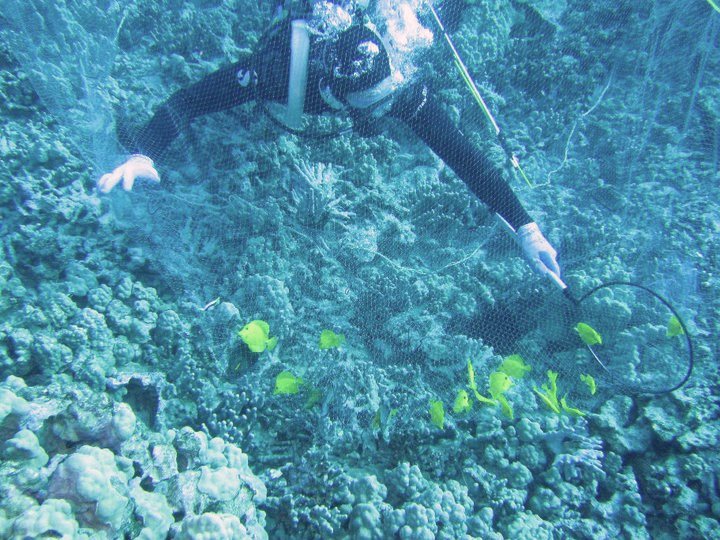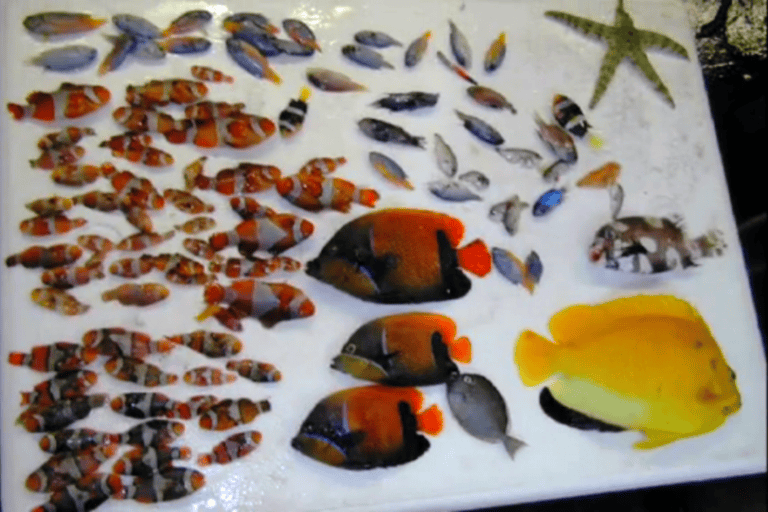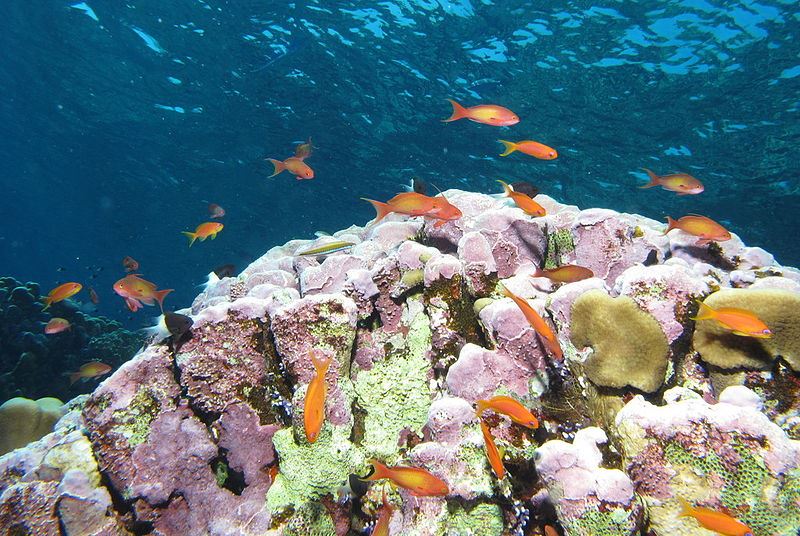- Cyanide fishing is often quicker and easier than other methods but is highly destructive to coral reef habitat, is used to catch up to 90 percent of saltwater fish that are imported into the United States.
- Most of the fish imported into the United States come from countries where cyanide fishing is prevalent and enforcement of fishing regulation is limited.
- For the Fishes’ ‘Tank Watch” app lists fish that are captive-bred vs wild caught and makes the information readily available to potential buyers of marine life.
- As efforts to strengthen enforcement improve fisheries management, consumers can use these lists to decide if the fish that they are looking to purchase are suitable for their personal aquariums.
The fish and other marine life displayed in household or public aquariums may conceal a dark secret. Many of the over 1,800 species of tropical fish bought and sold globally to populate aquariums are caught using the destructive and often illegal custom of using cyanide to stun fish. The lack of data and public awareness of this practice allows it to continue, harming reef ecosystems across the tropics.
In 2012, Rene Umberger, founder and Executive Director of the non-profit group For the Fishes, noticed the limited understanding of where the marine fish in private aquariums came from. She created a short reference guide identifying the species often involved in the harmful international trade.

Soon, because of the lack of knowledge concerning cyanide fishing and international fish trade, Umberger realized a tool was needed that could be easily accessed by conservationists and hobbyists to assess the sourcing of tropical aquarium fish.
From this, the app Tank Watch was launched in September, 2014 and has since been downloaded by over 14,000 people worldwide.

“We didn’t set out to use technology when we began our campaign to protect coral reefs and wildlife, but it now plays a major role in our projects,” Umberger said.
Tank Watch conveniently separates its listings into “Good Fish” and “Bad Fish” categories, in which potential fish buyers can search for specific species. The “Good Fish” list is based on a list compiled annually in CORAL magazine by field experts and includes all of the captive-bred species available to consumers, Umberger said. The “Bad List” identifies those fish that are caught in the wild, where supply chains are less traceable.
Some experts emphasize the need to shift business practices to those that promote local stewardship of reef fish in the wild. Nevertheless, data on current and sustainable fishing practices are scarce, so knowing whether a species is wild-caught or captive-bred may be as much information as can be made consistently available to the consumer.


The app allows consumers to sort the lists by family name, common name and/or color to customize their search for the fish they are considering purchasing. Easy access to the database allows consumers to quickly see whether or not the particular fish that they are interested in is likely to be captive-bred and, if not, whether an alternative captive-bred species exists.
Umberger says that only the individual seller can give final confirmation of the fish’s origin.
“Ultimately, we see Tank Watch as a global effort to raise awareness about illegal wildlife in the saltwater aquarium trade, reduce consumer purchases of these coral reef fish and invertebrates, and improve their status in the wild,” Umberger said.
Capturing marine life unsustainably and dangerously
Cyanide is often used to capture wild fish. Reef fishers squirt the toxic liquid into the fish’s face, or into crevices where fish hide, to stun it and catch it.
The fish often suffer immediately from their exposure to the toxin, and its effects weaken fish, making them more vulnerable to the stresses of transit and a new environment once in their aquarium owner’s tank.
Studies have found that “if rapidly moved to clean water about 50% survive the initial exposure…Even if fish survive the initial pulse-exposure…they are subject to a high delayed mortality (>80%) during export to other countries.”

In addition to directly harming the fish, the method harms other marine life in the process. Umberger said that for every wild fish sold for aquariums, several other fish, non-target reef creatures, and surrounding corals are killed from exposure to the chemical.
The practice is illegal in many countries, but the laws are not well enforced. Up to 80 percent of saltwater fish imported into the U.S. come from countries that frequently use this method, and techniques to detect cyanide excretion in harvested fish are still under development.
Lethal methods such as cyanide fishing are used to capture the “exotic” fish that many aquarium enthusiasts look to include in their tanks, as well as food fish in some Asian countries.
“Very few people, including aquarium enthusiasts, realize that nearly all of the marine life sold for aquariums is captured from the wild, most likely in unsustainable and destructive ways,” Umberger said. “This means that hobbyists are unknowingly contributing to significant harm and destruction of coral reefs and their wildlife…”
Today, fewer than 60 species–only two percent of the species imported in the U.S. annually—are captive-bred in a sustainable manner and thus suitable for commercial purchase. About 80 percent of wild-captured fish will die before they ever reach a tank, and almost all are likely to die within a year of their capture.

Making a difference
According to a recent poll conducted by For the Fishes, 81 percent of the public believe that only captive-bred fish should be kept in personal aquariums, even if the selection of available fish diminishes.

Additionally, a survey found that the majority of aquarium hobbyists who purchased wild-caught fish or were unsure of their origins in the past two years noted that fish purchases in their future would likely to be only captive-bred. These results came after they learned about the cyanide fishing issue through For the Fishes.
“By providing accurate information and correcting the widely-held misconception that captive fish were captive-bred, Tank Watch creates a ripple effect of awareness, behavior change, and intention,” Umberger said.

To measure the app’s success, For the Fishes obtains information from the U.S. Fish and Wildlife Service of in the number of wild-caught fish imported into the United States by the marine aquarium trade. The group acknowledges that there are several factors that play into the decreased import numbers, but their efforts on Tank Watch and education contribute to the success.
However, because Tank Watch can identify the fish species that are most commonly bred in captivity and those potentially wild-captured through its lists, it is up to the consumer to confirm with the seller that their purchase is captive-bred. Moreover, tracing the supply chain of wild-harvested fishes is difficult due to limited monitoring of trade and false claims by some traders that their fish were captive-bred.
Umberger said that the only way that consumers can be absolutely certain that they are buying captive-bred fish would be to buy a “designer” clownfish, which come in color morphs that are not found in nature. Given the uncertainty when purchasing tropical fish, the Tank Watch app aims to minimize the possibility of the purchase of an unsustainably wild-captured fish.

Efforts continue to strengthen supply chains for the aquarium trade, with the aim to creating a sustainable harvest of high-value reef fish that provide fishing communities with an alternative to other, more destructive fishing practices.
Unless supply chains can be verified as sustainable and non-destructive, purchasing captive-bred fish can help save the other fishes, reef invertebrates and corals that are indirectly affected by cyanide fishing.
“…Every captive-bred fish that’s purchased instead of a wild one saves a piece of one of the most beautiful and fragile ecosystems on the planet,” Umberger said.
Learn more about the use of cyanide in the documentary video below by Nanang Sujana:
Banner image is a pair of pennant bannerfish. Photo credit: Rob, Creative Commons
Editor’s note: This post has been updated to reflect additional data on the uncertainty of marine aquarium trade fisheries.
